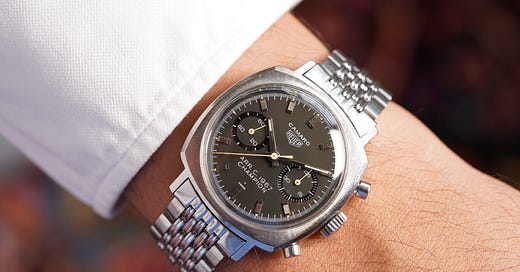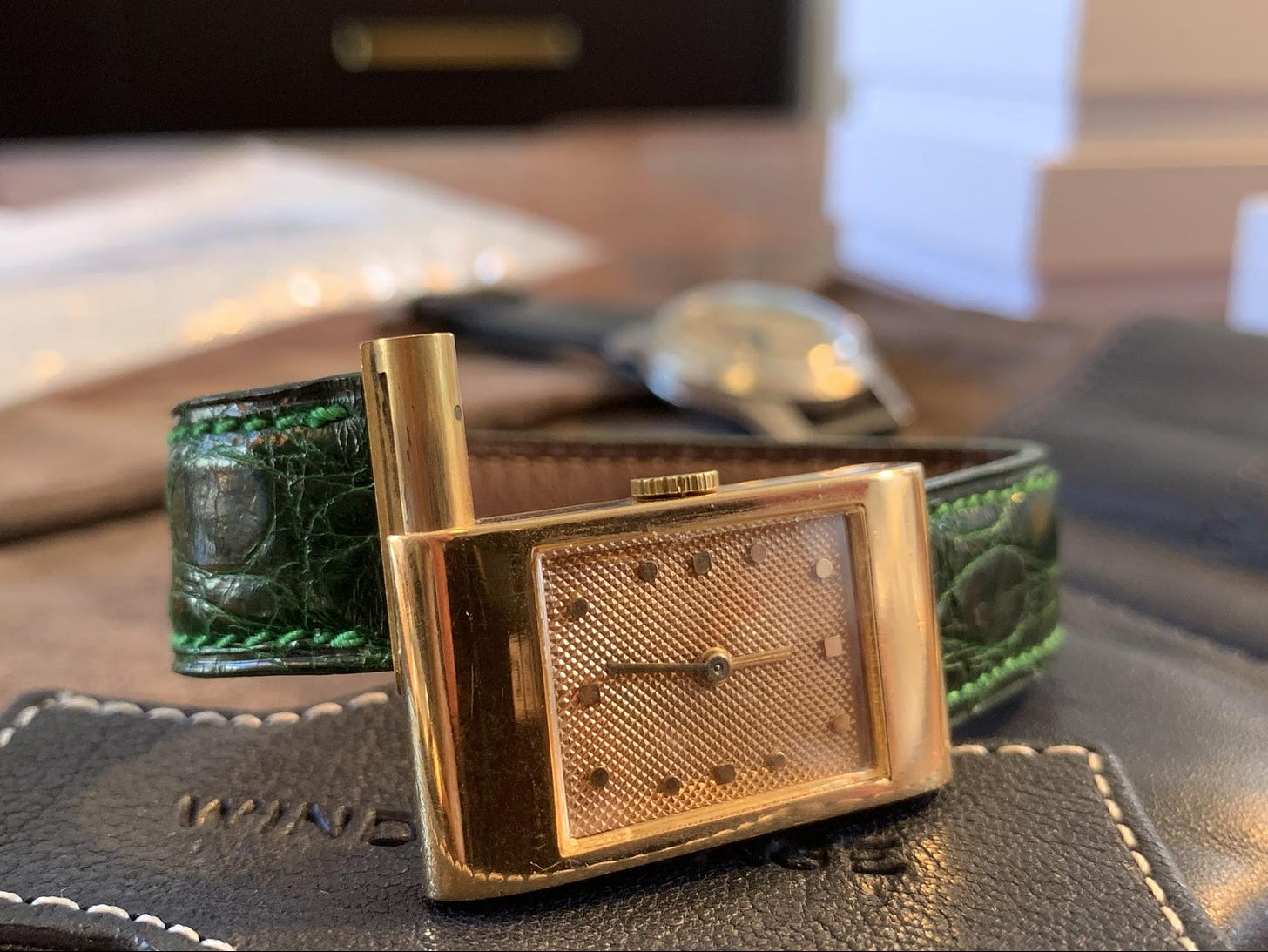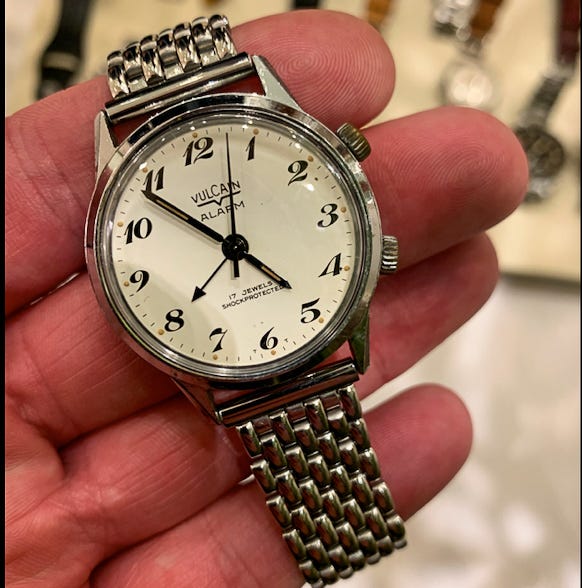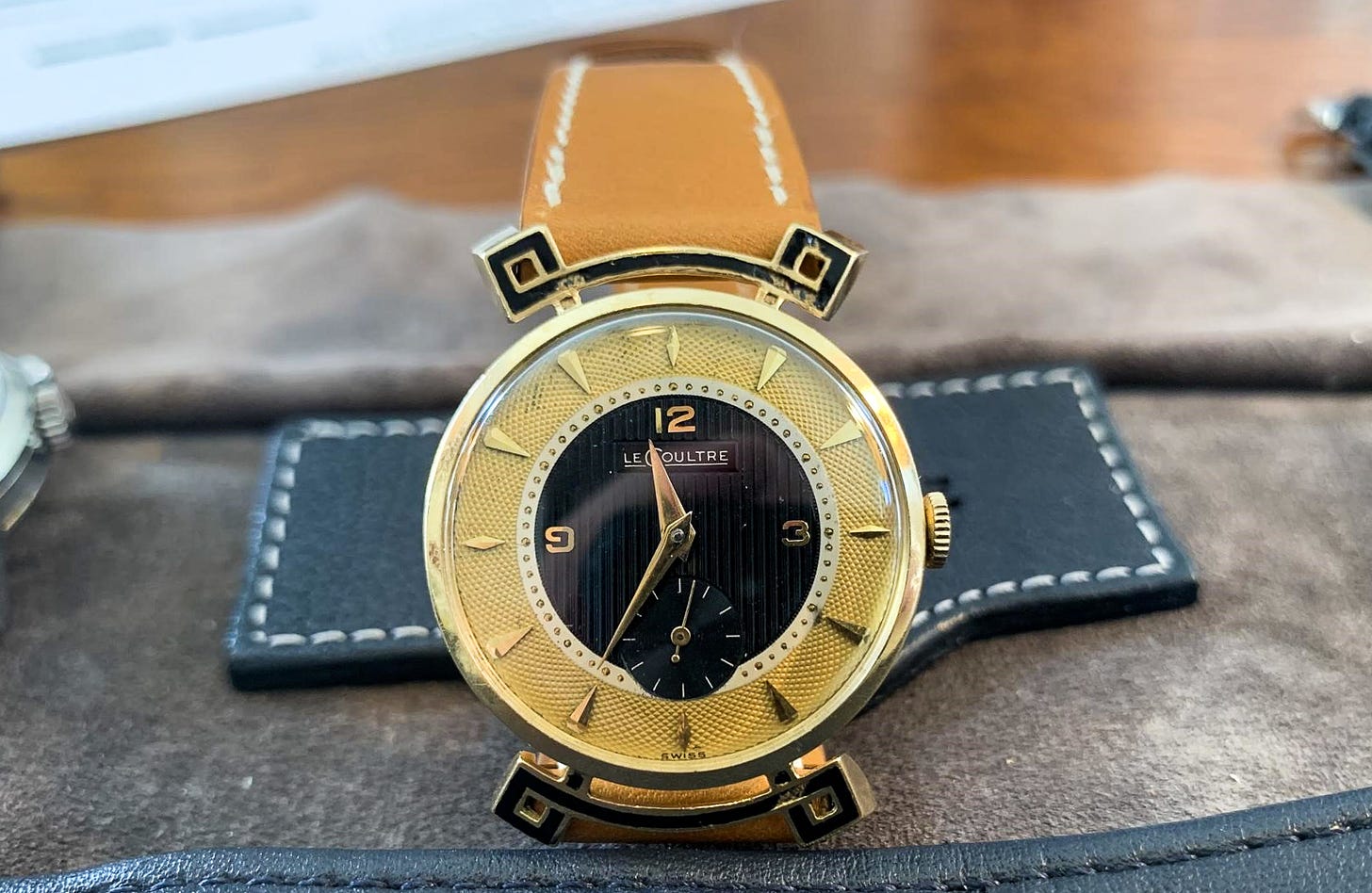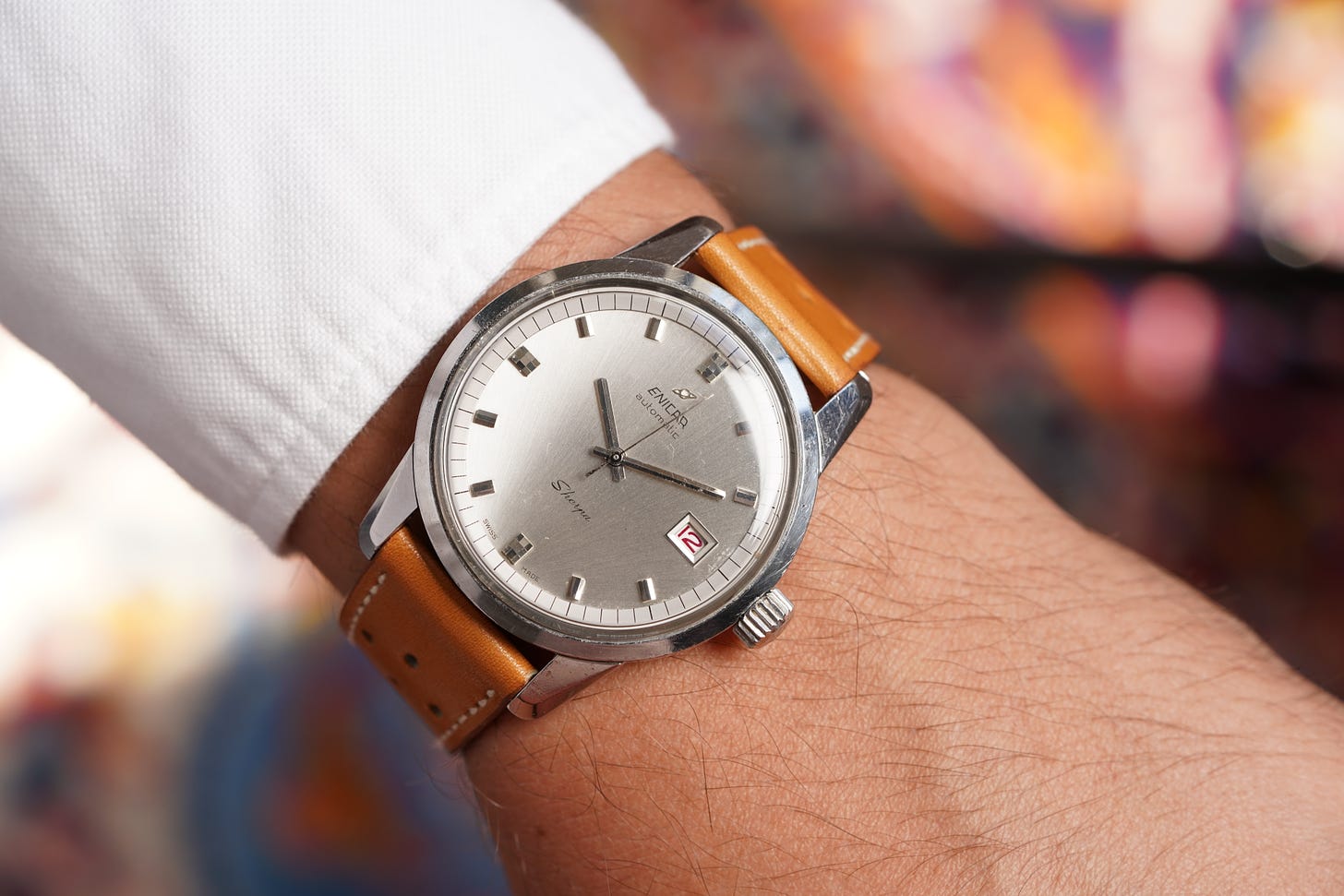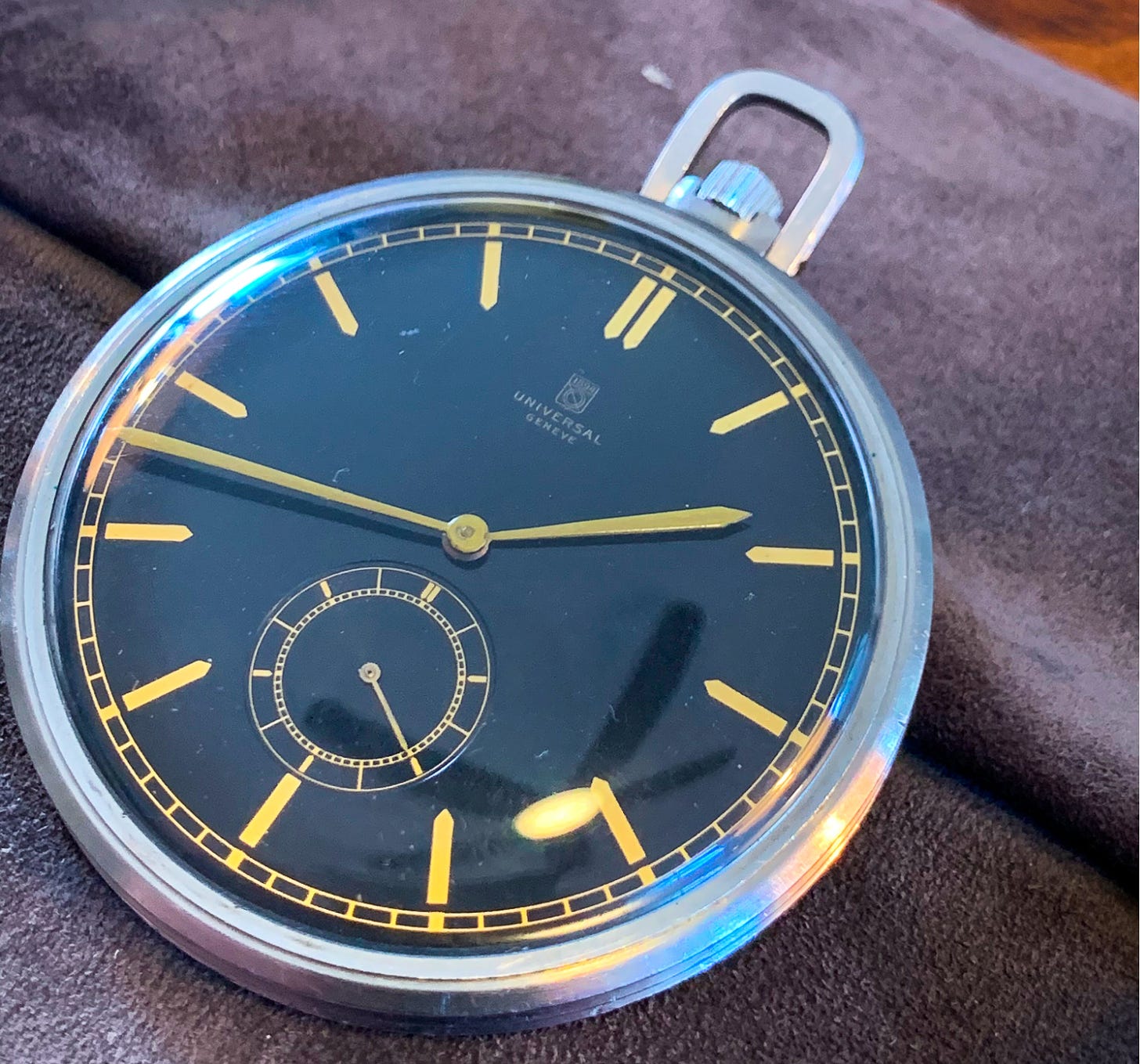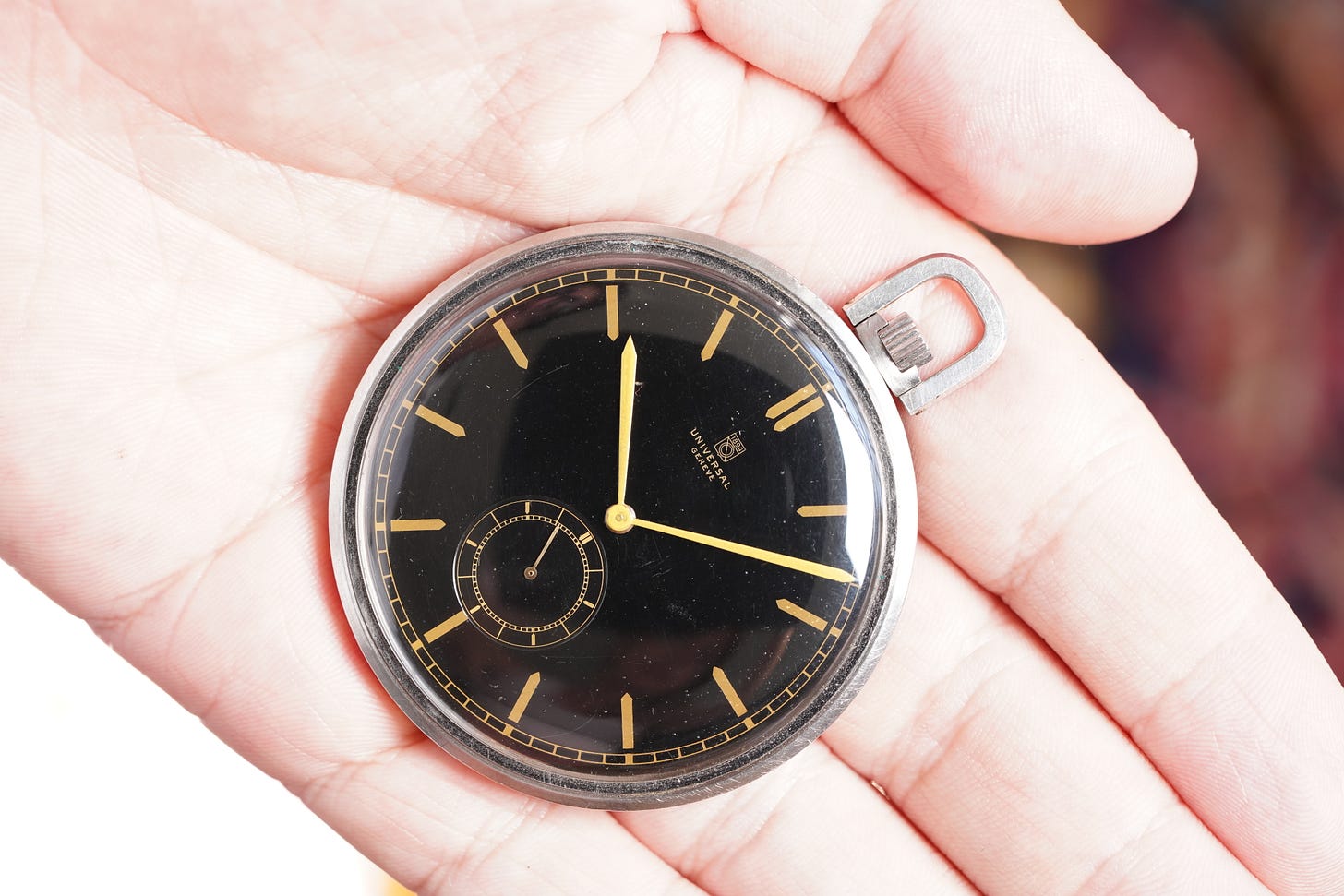Watching spotting in West Palm Beach with Wind Vintage (pt. 2)
A lavishly designed LeCoultre, a buzzing Breguet dial Vulcain Alarm, an American Road Racing Champions’ Camaro and more
Rescapement is an independent and irreverent weekly newsletter about watches. Subscribe now to get it delivered to your inbox every Sunday:

By: Charlie Dunne
In case you missed part 1 back in late March, I recently caught up with Eric Wind of Wind Vintage. After part 1 was published, we neglected to follow up with the sequel that was promised. While Eric’s business is very much centered around vintage Patek Philippe and Rolex, I requested some of the unexpected timepieces for Rescapement readers.
Boucheron Reflet (movement by Omega)

Upon noticing a copy of the new Reverso book by Nicholas Foulkes, Eric emphasized that I had to see a different, yet equally interesting interactive case design by Boucheron. This model is known as the “Reflet” and it is quite incredible. Most noteworthy is the top cylindrical end link which glides subtly into a locked state when securing the watch on the wrist. The other end is firmly fixed in place within the hooded bottom lug. I can only describe this as an experiential timepiece.
Prior to this 1950s model, Omega had already collaborated with some fantastic casemakers, such as in the production of the waterproof Marine by Frédéric Baumgartner. Rather than designed for water resistance, the Reflet is made strictly out of creativity. Despite the stigma of “designer” watches, jewelry houses have made many fantastic contributions to watch design.

Interestingly, Boucheron still makes the Reflet. While you can find some vintage examples by searching the web, it’s not a watch one comes across too often in the wild. Notably, Andy Warhol owned a Reflet, which can be seen in the Sotheby's Andy Warhol Jewelry and Watches catalogue from April 1988. However, the present watch is quite different in that the Warhol example accompanied a brick style bracelet and featured a different dial, signed “Boucheron.” The lot is described as a “gold rectangular wristwatch by Boucheron, Omega, 1950”, with the sliding end piece “patented by Boucheron”. As it would turn out, the caseback of Wind’s model would also feature an Omega logo stamped next to the retailer’s name. After sharing the watch on social, our knowledgeable friend Herman was kind enough to share the patent information which was applied for in November of 1944.
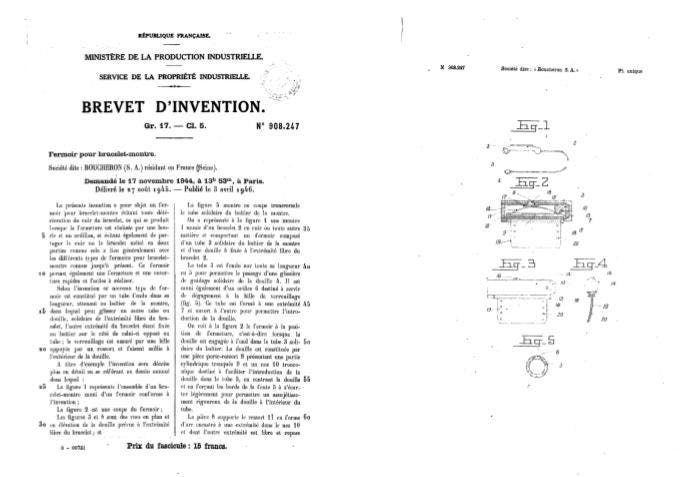
The case measures about 37mm in length and obviously would require a bit of artisanal expertise if you’re constantly changing straps. Inside, the watch features the manually wound calibre 302 by Omega, which appears to have been introduced in the same period as this watch. Despite the other example’s Warhol provenance, this anonymous, honeycomb dial is more up my alley.
Vulcain Alarm
The oddball cousin of the Cricket family is most certainly the Vulcain Alarm. Yes, Vulcain’s seminal watch line was making noise as a favorite timepiece amongst US Presidents. However, with the emergence of alternative quartz-powered watches, not everyone was able to afford a real deal Cricket (or a purported 200 in the case of President Lyndon B. Johnson).
As a result, Vulcain, along with many other brands, pivoted towards creating watches at a lower production cost. It is at this point that the La Chaux-de-Fonds brand introduced the Vulcain Alarm model. In addition to the chrome-plated cases, the dials are absent of the iconic “Cricket.” Scaling back for the more cost-effective movement, Vulcain opted for one by A. Schild SA. The watch features a calibre AS 1475, which was one of the most widely used alarm movements and can be found in brands such as Wakmann, Tissot, Enicar, Benrus, Helbros, and Tudor. In contrast to the Cricket’s alarm, the calibre AS 1475 does not sing nearly as loud. In Michael Philip Horldbeck’s book, The Alarm Wristwatch: The History of an Undervalued Feature, the author attributes this to the fact it only uses a single membrane (unlike the Crickets, which feature a double membrane). Nevertheless, Wind’s appreciation for the Cricket’s distant cousin remains. “The Breguet numerals capture a certain refinement not seen in the other models. It’s one of the most sophisticated dials from the brand,” he said.
A smooth beads of rice bracelet accentuates the overall clean aesthetic. The alarm hand is much shorter in length, which may result in a bit of a learning curve in setting the alarm for precision. Comparatively, the early Vulcain Crickets would feature an exterior decimal scale which allows for an approximate reminder in the near future. The extremely sharp case and crisp dial give off a super elegant first impression.
Art Deco LeCoultre
One timepiece that I felt extremely fortunate to handle was this eccentric time-only LeCoultre. To me, this LeCoultre warrants the same level of admiration as the most incredible cases from Patek (or any other brand, for that matter). It makes your jaw hit the floor upon first glance. Interestingly enough, the exterior of the dial has a brilliant beaded guilloché reminiscent of a Patek ref. 2550 or ref. 2549.

This dial epitomizes layering and texture. The internal, vertically embossed black dial creates more balance to the aesthetic, allowing it to be worn in a formal setting. However, the black enameled lugs are emphasized against the tan strap (a go-to for Wind Vintage). With a black strap, these lugs wouldn’t take on as dramatic of a look, which they deserve. Despite being a round case, it has an unconstrained design that speaks to the rich imagination of mid-century watchmaking. It’s as if the case designer intentionally sought out to abandon conventional norms in pursuit of a more poetic approach.
One detail that didn’t go unnoticed on the caseback was the stamped “D&A”. The imprinted initials denote DiVincenzo & Arienti, a casemaker out of New York. Many Swiss watches were taxed at a very high rate during this period, and to mitigate this, brands such as Jaeger-LeCoultre would send their watches to the U.S. to be “assembled” by Americans (thus “LeCoultre''-only dials were destined for the U.S. market). Markings like these help paint the full picture for collectors.
Interestingly enough, Wind pulled out a ziplock with a Rolex inside to provide more context. He explained that many time-only Rolexes were by the same casemaker, and more often than not, these were given by companies to commemorate an employee’s anniversary at the company. He would go on to make the case for the importance of original condition, saying “oftentimes you will be able to find engravings of the employees or companies. Sadly, some people are erasing this history by polishing them out.”
Enicar Sherpa
Transitioning to a less flamboyant watch, we’ll segway to a brand that has been garnering more appreciation among sports watch collectors over the past few years. This Enicar Sherpa has incredible presence at 40mm and features the broad, bold lugs commonly associated with the brand. The case manufacturer is Ervin Piquerez SA (EPSA). Renowned for the impermeable bayonet closing system, Sherpas maintain an innovative technology that is recognized as a milestone moment in dive watch history. The logo is an “isolated Saturn”, meaning that the brand’s name is no longer dividing the gas giant. In his book, Enicar: Time For A Change, Martijn van der Ven identifies this as the third phase for the Lengnau brand’s logo, which would be adopted in the early 1960s and used through the beginning of the 1970s.
The groovy hour markers are subtle but exciting, best appreciated in a dim setting. Out of all the Sherpas I’ve encountered, I find this one to be among the few capable of having a dressier look. Absent Enicar’s signature colorful bezel or hands, the watch has a very pure look with just the slightest pop of red on the date window.
Universal Geneve Pocket Watch
I have begun to appreciate pocket watches a bit more in recent years. This Universal Genève is just another perfect example of how diverse the manufacturer's history really is. Certainly more renowned for complicated wristwatches, this UG, albeit a sober timepiece from the 40s, is a piece of art. Rather than being presented upright in a stand, it’s versatile on its caseback showcasing a channeled, knife-edge profile. Laid flat, it is a pocket watch one can truly marvel at while making for a fantastic addition to any office desk.
One of only three case styles identified, a similar version without the subsidiary seconds and UG logo was sold at Sotheby’s in 2018. That example belonged to the filmmaker Josef Von Sternberg and had been given to him by the German novelist Erich Maria Remarque.
1967 Heuer Camaro American Road Racing Championship
Some watches lead the pack and this Heuer Camaro is certainly that type of watch. Upon my first glance at the dial, it was clear (even to a Heuer novice like myself) that this watch accompanied a story. It’s no secret that Heuer’s history with automotive racing drives collectors mad with passion, having earned its place as an essential tool for drivers that entrusted their lives with these chronographs on the track.
Often, winning race drivers were recognized with a watch post victory, with an engraved caseback to signify the victory. But Heuer stands out as often giving watches with a customized dial instead, offering more visibility of the provenance. In hindsight, this was not only a very smart approach for the brand’s association with the most prestigious races, but it has become one more detail for collectors to search for.
These models from Heuer include the Shelby Cobra, Champion, MG, and most notably the Indianapolis Motor Speedway. When sharing the story of hunting down this watch, it was evident that it was not only an important find for Eric on a professional level, but also a very personal moment as a collector in his own right.
“The search for this watch began in 2012-2013,” Wind recalled. “I had initially bid too low when I first came across it on eBay. I would quickly learn that Jeff Stein [of On The Dash] had also been bidding on behalf of the Tag Heuer Museum, so I decided to step aside.” As fate would have it, the museum would go on to be outbid, leaving the timepiece’s whereabouts a mystery.
Yet soon after, Wind would attend the 2013 Tag Heuer Collector’s Summit and low and behold, the watch was on the wrist of another attendee. Wind recalled asking “Is that the one from eBay?” only to confirm the locality of the one that got away. After a bit more research into the race’s program, Wind discovered that the pamphlet from that year cited the winners would receive a Carrera 45. “Obviously it was around this time that they were transitioning to the Camaro, so that was the last one found from its introduction”.
He would go on to share how the watch was even more significant outside of the American Road Racing Championship provenance.“The common understanding was that the Camaro was introduced in 1968, and here we have an example that rewrites history in that this is from 1967.” Ironically, this wouldn’t be the first time Wind has written about a Heuer that rewrites the history of the brand. In 2013, he did the same for the Heuer Carrera when he wrote The Very First Heuer Carrera, Explained for Hodinkee.
Wind would finally get his long-awaited second chance at an ARR. C. Camaro while in communication with the family of Charles Kemp Kirkbride II, the winner of the Formula A class and the only one to finish in his division. Wind would elaborate in a recent post how proud Charles was of the timepiece and that it was worn with passion long after that victory back in ‘67. “It’s just an incredible watch and one of my favorite periods of Heuer,” Eric said with a wide grin while staring at the keeper.
Acknowledgments: Special thanks to Eric and Christine Wind for providing beautiful photography and access to these spectacular watches. For additional context on the Heuer Camaro, see ‘The Underrated Heuer Camaro: Its Origins and Legacy’ by Eric Wind in Revolution Watch Asia issue 62.
Rescapement is a weekly newsletter about watches. If you enjoyed this week’s ‘sletter, please subscribe to get more exclusive articles like this delivered directly to your inbox every Sunday:


